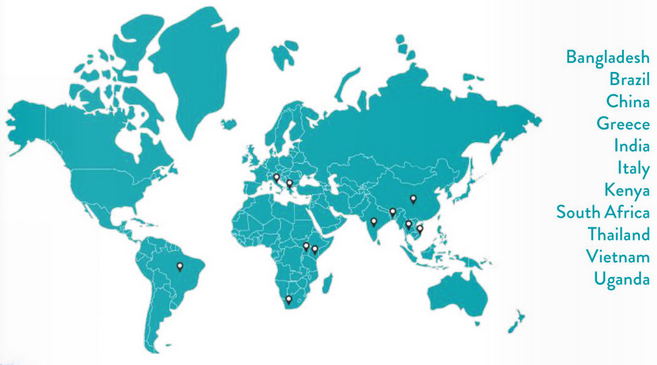News on Neonatal Sepsis and Antibiotic Resistance
A large observational study of infants with sepsis shows the impact antimicrobial resistance is having on this vulnerable population.
Over 20 million sepsis cases in children worldwide
Despite great improvements in the mortality rate of children under the age of 5, sepsis remains one of the leading causes of death in infants. The Global Burden of Disease study published in 2020 estimated that in 2017 there were 20.3 million cases of sepsis worldwide in children under 5, and an estimated 2.9 million deaths. The highest incidence and mortality was found in infants, with the greatest prevalence in low- and middle-income countries, sub-Saharan Africa and Asia.
The WHO recommends a standard empirical treatment of ampicillin and gentamicin for neonatal sepsis, which is administered within hours of its onset to prevent tissue damage, organ failure and infant death. This recommendation is based on data from high-income countries. Few data exist on how neonatal sepsis is treated in low-income countries, where multi-resistant pathogens are more prevalent and access to diagnostics is limited.
Looking for a clearer picture of the mortality and treatment of neonatal sepsis worldwide, the Global Antibiotic Research & Development Partnership (GARDP), together with researchers from several universities and hospitals examined data from 19 hospitals in 11 high-, middle- and low-income countries on four continents. The study included 3,204 infants hospitalised for less than 60 days with a main diagnosis of sepsis between August 2018 and February 2020.
Resistance to antibiotics complicates the treatment of neonatal sepsis
A GARDP study examined mortality as well as antibiotic treatment and resistance among more than 3,200 infants with suspected neonatal sepsis in hospitals in 11 countries. It found that more than 11% died during the course of the study. Mortality rates varied from 1% to 27%.
The mortality rate at 28 days stood at 11.3%, rising to 17.7% for cases with a positive blood culture. More than half (59%) of the infection-related deaths resulted from a hospital-acquired infection. The most common baseline pathogen detected was Klebsiella pneumoniae.
The analysis of antibiotics, which was initiated within 24 hours of the baseline blood culture, showed a wide variation between hospitals, with ampicillin and gentamicin administered in only 12.8% of the cases. Over 20 other antibiotic combinations were applied. Many hospitals used a combination of antibiotics without much evidence to support such use. The most widely practised treatments were those offering some activity against ESBL-producing (extended-spectrum beta-lactamase) bacteria and/or Pseudomonas infections, which accounted for a third of cases.
The limited use of the WHO-recommended therapy can probably be attributed to the increasing resistance to ampicillin and gentamicin. Research showed that 98% of K pneumoniae and 90% of Escherichia coli isolates were resistant to ampicillin, while 72% and 38% respectively, were resistant to gentamicin. There were also high resistance levels to the second-line treatment, cefotaxime. In K pneumoniae isolates, resistance to meropenem was above 25%.
New data and guidelines needed
The study authors state that the results highlight both the need to update antibiotic treatment guidelines for neonatal sepsis and the general lack of treatment options for infants with multi-drug-resistant infections.
The GARDP is also using the data from the study to plan an interventional trial that will examine the safety and efficacy of antibiotics commonly used for neonatal sepsis, along with three potential new treatments – fosfomycin, amikacin and flomoxef – that appear to promise good efficacy when used in combination. This trial is expected to be launched this year in Kenya and South Africa, with the main trial scheduled for 2023.
Source:
Russell, Neal and Stöhr, Wolfgang and Plakkal, Nishad and Cook, Aislinn and Berkley, James A. and Adhisivam, Bethou and Agarwal, Ramesh and Balasegaram, Manica and Ballot, Daynia and Bekker, Adrie and Berezin, Eitan Naaman and Bilardi, Davide and Boonkasidecha, Suppawat and Carvalheiro, Cristina G. and Chaurasia, Suman and Chiurchiu, Sara and Cousens, Simon and Cressey, Tim R. and Dien, Trah Minh and Ding, Yijun and Dramowski, Angela and DS, Madhusudhan and Dudeja, Ajay and Feng, Jinxing and Glupczynski, Youri and Goossens, Herman and Islam, Mohammad Shahidul and Jarovsky, Daniel and Khavessian, Nathalie and Khorona, Meera and Kostyanev, Tomislav and Larsson, Matthias and Luca, Maia De and Malhotra-Kumar, Surbhi and Mussi-Pinhata, Marisa M. and Nanavati, Ruchi and Nangia, Sushma and Nankunda, Jolly and Nyaoke, Borna and Obiero, Christina W. and Owor, Maxensia and Ping, Wang and Preedisripipat, Kanchana and Qazi, Shamim and Ramdin, Tanusha and Riddell, Amy and Roilides, Emmanuel and Saha, Samir and Sarafidis, Kosmas and Thomas, Reenu and Velaphi, Sithembiso Christopher and Vilken, Tuba and Wang, Yajuan and Yang, Yonghong and Zunjie, Liu and Ellis, Sally and Bielicki, Julia and Walker, Sarah and Heath, Paul T. and Sharland, Mike, Analysis from the NeoOBS Global Neonatal Sepsis Prospective Observational Cohort Study Across 19 Hospitals in 11 Countries; Clinical Presentation, Treatment, Mortality Outcomes and Development of the NeoSEP Sepsis Severity Score. Available at SSRN: https://ssrn.com/abstract=3864901 or http://dx.doi.org/10.2139/ssrn.3864901
